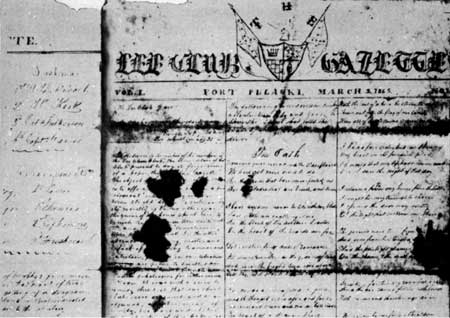|
FORT PULASKI National Monument |
 |

Prisoners' newspaper, Fort Pulaski, March 2, 1863.
Courtesy Mrs. Irving McKesson.
The Last Salute
Now the actors come on stage for the final curtain in the drama of Fort Pulaski! Sherman had rested in Savannah and had gone north through the Carolinas to Bentonville and Durham. Grant had met Lee at Appomattox. The defenders of Fort Sumter had laid down their arms. The Confederate armies had been crushed on the battlefields. Gillmore had returned to command the Department of the South, and the destiny of Fort Pulaski was again in his hands.
On April 29, 1865, 200 guns were fired from the ramparts of Fort Pulaski to mark the surrender of General Lee—the end of a great military career which had begun on Cockspur Island more than 35 years before.
A few weeks later the conquering forces captured the President of the Confederate States. In command of the detail which took Mr. Davis was Brig. Gen. J. H. Wilson, of the Topographical Engineers, who 3 years before had brought to Fort Pulaski the demand for surrender. Mr. Davis was captured in middle Georgia and sent down the Savannah River to Hilton Head Island for transport to Fortress Monroe. Accused of complicity in the assassination of Abraham Lincoln and under orders to be treated as a dangerous criminal, the Confederate president spent his last night in Georgia aboard ship in the lee of Cockspur Island. Next morning as he was brought to Hilton Head, Negroes, lining the shores of the islands, chanted "We'll hang Jeff Davis to the sour apple tree!"
To the grim fort on Cockspur Island were brought leaders of the Confederacy, some to remain many months in prison, while an angry nation sought the illusive satisfaction of vengeance. In the list of distinguished prisoners were 3 cabinet officers: Secretary of State Robert M. T. Hunter, Secretary of the Treasury George A. Trenholm, and Secretary of War James A. Seddon, as well as Assistant Secretary of War John A. Campbell. In addition, there were 3 State governors, Andrew G. Magrath of South Carolina, Andrew B. Moore of Alabama, and Alexander K. Allison of Florida; 1 senator, David L. Yulee of Florida; and Brig. Gen. Hugh W. Mercer, who as colonel of the 1st Regiment of Georgia had once been in command of Fort Pulaski.
The Confederacy had been defeated and the streets of Savannah were patrolled by blue-clad soldiers, but the spirit of the men and women, who more than 4 years before had demanded the seizure of Fort Pulaski, was still unbroken. The stores were all open. Business of every sort progressed precisely as usual. The streets were filled with native citizens, dressed somewhat antiquely, but giving no sign of suffering. A smart sailor from a Federal gunboat summed up the scene, "Hell," he said, "this town isn't dead; it's wound up and running." "It was the rebel Savannah unchanged," wrote Whitelaw Reid, the famous war correspondent.

|

|
|
Last Modified: Mon, Mar 4 2002 10:00:00 pm PDT |


